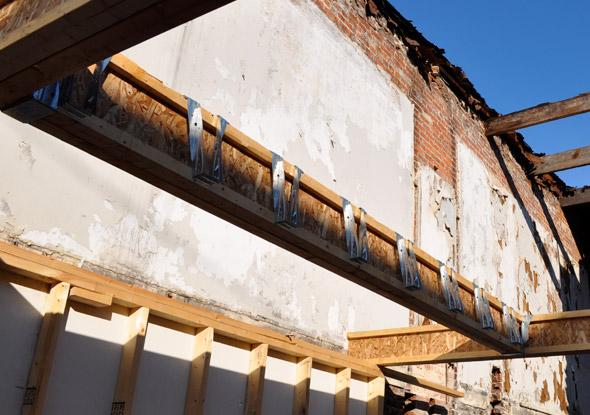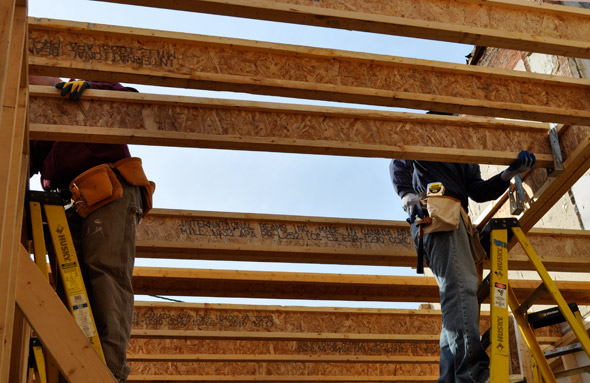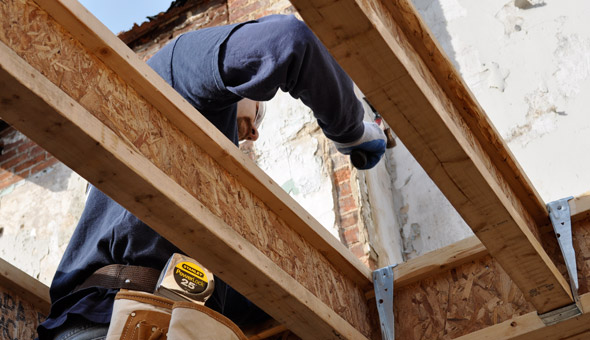
Yesterday, Fred mentioned our work with Habitat for Humanity in Sandtown. I had a lot of fun working this remodel and would urge everyone to find an opportunity to volunteer. We began the day by completing the installation of about 8 floor joists for the second floor. This post focuses on wood I-beam floor joists and how we installed them. You can read Fred’s original post on installing a plywood subfloor from yesterday, which actually occurred after these floor joists were installed.
More Info on TJI’s
Wood I-beam joists, also called TJI’s (for Trus Joist I-Joist), resemble steel I-beams. They are composed of a top and bottom flange with a piece of plywood or OSB fixed perpendicular in between the two. Flanges range in size from 1½” – 2½” wide and depths vary depending on application (residential or commercial) and spanning distance. For more information on TJIs and other floor joists, check out my article comparing floor joists.

Benefits of Wood I-Beam Joists
Engineered beams have become the preferred choice for new structures because of all the benefits they provide. Here’s a short list of the benefits of wood I joists, by characteristic.
- Rigidness
Maybe the biggest benefit of using wood TJI joists is their rigidity. TJI’s are very stiff and have limited deflection compared to traditional solid wood joists. This is an important characteristic when you consider the stringent deflection requirements for natural stone and ceramic tile. - Span
These joists can also span larger distances than traditional wood joists. A joist 16 inches deep and spaced 16 inches apart can span about 26 feet. - Warping & Twisting, Uniformity
Engineered beams are manufactured to be very consistent. With TJI’s, you’ll find they are very straight and have minimal twisting and warping. They also have very little dimensional shrinkage, which means easier installation and more uniform surface flooring. - Flange
I consider the flange width to be another advantage. It provides a wide surface for nailing, screwing and gluing the subfloor. This can be particularly helpful if the room is slightly out of square or if a single joist is slightly mispositioned. - Green
The eco-friendliness of TJI’s is a little clouded. On the one hand, solid wood joists are typically made from old growth trees that are tough to replace. I-joists use less wood and are made from several different pieces. However, there is some off-gassing that takes place in the manufacturing process, but ultimately I think they are a smart choice considering the benefits and ability to use new growth trees.

Install TJI Wood I beam Floor Joists
Framing a floor with I-joists is very similar to using dimensional lumber. In the first picture you can see that we are mounting the joist flush up against another to work around a staircase. This flush-framed method calls for galvanized hangers to support the TJI joist. We took special care to place them 16″ OC and used 1 ½” nails to secure them in place. Only nail one side of the hanger, then set the I-beam in place and nail the other side.
On the opposite side, the I-joist rests on top of of a beam. This is the drop-framed method and we nailed these joists to a rim board. Take special care walking on I-joists before the plywood sheathing is installed as they are not as stable.

What do you think? Do you have I-joists in your home?







so what would the drawbacks, if any, be?
Solid wood joists burn slower so in case of a fire, they’ll hold your weight longer. I also mention in the article that there is some off-gasing from the OSB adhesives. Other than that, I think they’re a great option.
Just installed 12″ TJI joists acrossed a 24′ span suporting a loft area, because of the existing structure all joist could not be on 16″ centers 2 of the joist are on 18″ center. Will this afect the suport of the floor, and do these TJI joists need any center blocking or cross bracing.